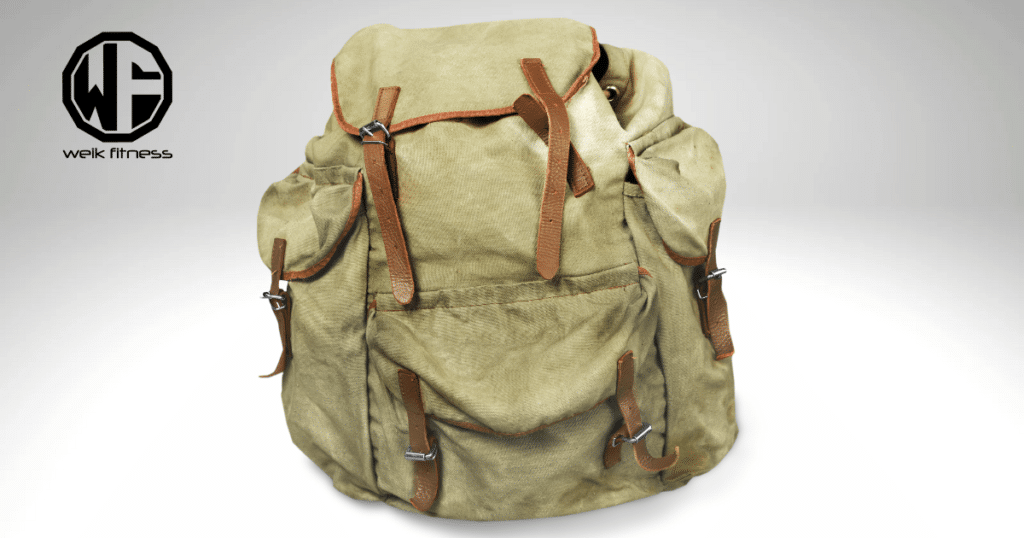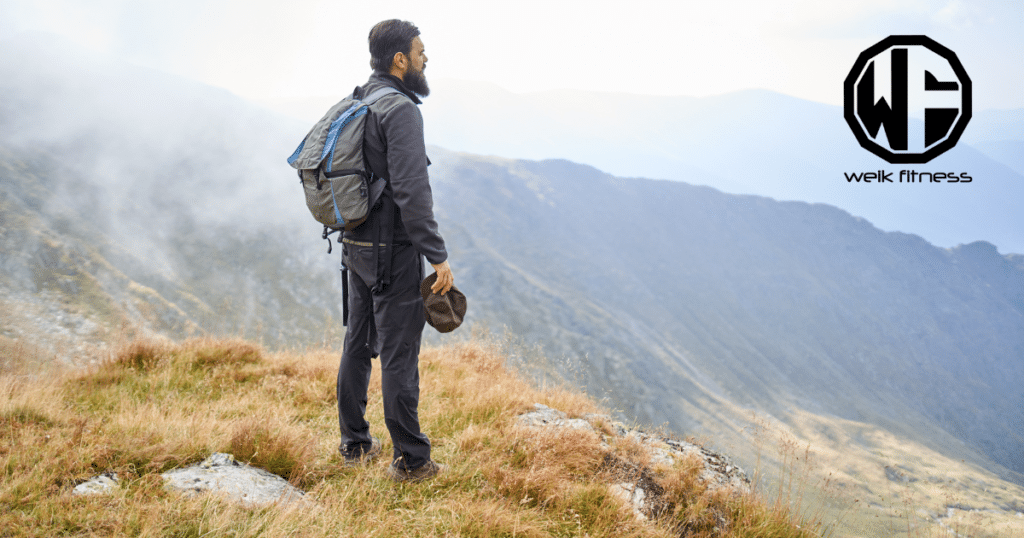Intro to Rucking: Everything You Need to Know About Rucking
Have you been interested in rucking but felt unsure where to start? Many people feel the same way. Rucking is a straightforward yet powerful workout that involves walking with a weighted pack (some people also use weight vests). This new fitness trend has taken off as Americans have fallen in love with it rather than being a slave to the treadmill.
This functional fitness, full-body workout got its roots in military training and offers a unique mix of cardio and strength training all rolled into one. Rucking is a great way to get in a workout without it feeling like a workout. You’ll burn a ton of calories without even realizing how long you’ve been rucking.
When I first encountered rucking, I was pretty confused, too. I’ve seen guys like Andy Frisella doing it, but I wasn’t sure what all it involved. But after researching and trying it myself, I’ve come to see it as an excellent, low-impact exercise. It’s great for your heart, builds strength in your legs and core, and even gives your mental health a boost.
In this guide, we’ll dive deeper and explain everything you need to know about rucking. From the essential gear to beginner-friendly techniques, I’ve covered all the important aspects. Let’s dive into rucking and why you should give it a try as part of your fitness routine.
Disclaimer: This article is for informational purposes only and is not meant to treat or diagnose any condition. It is recommended that you speak with your doctor before starting any exercise program, changing your daily nutrition, or adding any supplements to your regimen.
Table of contents
Key Takeaways
- Rucking is a simple workout that involves walking with a weighted backpack, combining cardio and strength training.
- Start with 10% of your body weight in your pack and gradually increase weight and distance over time.
- Essential gear includes a sturdy backpack with padded straps and a separate compartment for weights.
- Rucking boosts heart health, builds leg and core strength, and improves mental wellness.
- Begin with short 15-20 minute walks, focus on proper posture, and listen to your body to prevent injuries.

What is Rucking?
Rucking is a simple yet powerful fitness activity. It involves walking with a weighted backpack, blending cardio and strength training into one workout.
Defining Rucking
I love this fitness trend and I love that I get to do it outdoors. It’s a simple yet powerful workout that involves walking with a weighted backpack. As a fitness enthusiast, I’ve found rucking to be an excellent way to boost my strength and endurance.
The concept is straightforward: you strap on a pack, add some weight (or simply use a weighted vest), and hit the trails or streets. It’s like hiking with purpose, giving your body a challenge while enjoying the outdoors.
RELATED: Weighted Vests Are a Hot At-Home Piece of Workout Gear
I started with just 10% of my body weight in my pack, which is what experts recommend for beginners. Over time, I’ve increased the weight and distance, seeing great improvements in my overall fitness.
Rucking has its roots in military training, but it’s gained popularity among civilians looking for a low-impact, high-reward exercise. Unlike running, which can be tough on the joints, rucking is gentler while still providing a solid cardiovascular workout.
I’ve noticed it’s especially good for strengthening my legs and core. Plus, it’s versatile — I can ruck alone for some quiet time or with friends for a social fitness experience. The beauty of rucking lies in its simplicity and effectiveness, making it a great addition to any fitness routine.
Rucking’s Military Origins
Rucking has deep roots in military training. Soldiers have used this method for centuries to build strength and endurance. I’ve learned that it started as a way to move supplies and gear over long distances.
Troops would carry heavy packs on their backs for miles. This helped them prepare for the physical demands of combat.
My research shows that rucking became a key part of military fitness in the early 20th century. The U.S. Army made it a standard practice during World War I. They found it was the most simple and effective way to get soldiers ready for battle.
Today, many branches of the military still use rucking in their training programs. It helps build both physical and mental toughness. As a fitness enthusiast, I’ve tried rucking and can vouch for its challenging nature.
Rucking Gear Essentials

Picking the right gear is key to a good rucking experience. You’ll need a sturdy backpack and weights to get started.
1. Choosing the Right Rucksack
I’ve found that picking the right rucksack is key to a good ruck. A comfy pack like the GORUCK Rucker works well. It should have enough space for weights and gear. I make sure my pack fits snugly and has padded straps.
This helps prevent sore spots on long walks. Pockets are handy for storing small items and water bottles. A sturdy build is vital — you don’t want seams ripping mid-ruck!
For my rucks, I use a Wolf Tactical vest that has compartments built in to place your weight plates. This keeps them from shifting around. I also look for a bag vest with a chest strap and/or waist belt. These help distribute the load evenly across my body.
My go-to rucksack is water-resistant, too. It keeps my stuff dry if I get caught in rain during a ruck.
2. Selecting Appropriate Weights
Picking the right weight for rucking is key. I start my clients with 3-5% of their body weight for a mile or 20 minutes. This gentle start helps build strength without risking injury.
As they get stronger, we bump it up to 10-15% of body weight for 1-2 miles. The sweet spot for most people is 10-20% of body weight. It’s enough to challenge you but not so much that you’ll struggle or hurt yourself.
Always listen to your body and adjust as needed. Your ruck should feel tough but doable.
Health and Fitness Benefits of Rucking

Rucking packs are awesome for your health and fitness. It boosts your heart health and builds strength in your legs and core.
1. Cardiovascular Health Enhancement
I’ve seen amazing heart health gains from rucking. It gets my ticker pumping at 60-70% of max heart rate — right in that sweet spot for cardio benefits. This steady, moderate exercise strengthens my heart and blood vessels over time.
I feel my endurance improving with each ruck.
RELATED: Exploring Nature’s Playground — A Guide to Trail Running
Rucking also burns serious calories. The added weight makes my body work harder, boosting my metabolism. My resting heart rate has dropped, and my blood pressure looks better at checkups.
Plus, I sleep like a rock after a good ruck. It’s a simple way to enhance my overall cardiovascular fitness.
2. Leg and Core Strengthening
Rucking packs a punch for leg and core strength. I’ve seen my own legs and abs get stronger from regular rucking. It works many muscle groups at once, hitting your quads, calves, glutes, and core.
The weight on your back makes your body work harder with each step. This builds muscle and boosts overall strength over time.
Consistency is key for getting the most out of rucking. I try to ruck 2-3 times a week to keep seeing gains. The great thing is you can start light and slowly add weight as you get stronger.
Even 20 pounds in your pack will challenge your muscles. Rucking fits all fitness levels. I’ve moved up to carrying 30 pounds in my Wolf Tactical vest.
Whether you’re just starting out or already in good shape, you can tailor the weight and distance to your needs.
3. Mental Wellness Advantages
I’ve found that rucking does wonders for my mental health. It boosts my mood and helps me sleep better at night. When I ruck outdoors, the sunlight hits my skin and releases feel-good chemicals in my brain.
This simple act makes me happier and more relaxed.
RELATED: The Best Outdoor Workouts to Spice Up Your Training
Rucking also pushes me to explore new places, which adds excitement to my life. I often meet other ruckers on my trips, forming new friendships. These social bonds keep me accountable for my fitness goals.
The mix of physical challenge, nature, and social ties creates a powerful combo for my mental wellness.
Getting Started with Rucking

Ready to start rucking? I’ll show you how to begin this great workout. You’ll learn easy steps to ruck safely and set smart goals for your fitness journey.
Rucking Techniques for Beginners
I’ve learned some great rucking tips for beginners. These techniques will help you start your journey safely and effectively:
- Choose the right gear: Pick a comfortable backpack and start with 10-15 pounds of weight.
- Focus on posture: Keep your back straight and shoulders relaxed while walking.
- Start slow: Begin with short 15-20 minute walks to build endurance.
- Warm up first: Do light stretches before each rucking session to prevent injury.
- Hydrate well: Drink water before, during, and after your ruck to stay hydrated.
- Pick the right terrain: Start on flat paths and slowly add hills as you get stronger.
- Use proper footwear: Wear sturdy, comfortable shoes with good ankle support.
- Maintain a steady pace: Aim for a brisk walk rather than running or jogging.
- Listen to your body: Take breaks if needed and stop if you feel pain.
- Track your progress: Use a fitness tracker to monitor your distance and pace.
- Gradually increase weight: Add 2-3 pounds each week, if you can, as you build strength.
- Schedule rest days: Allow time for recovery between rucking sessions.
- Join a group: Find local rucking clubs for support and motivation.
- Mix up your routes: Try new paths to keep your workouts interesting.
How to Set Goals and Progress Effectively
Setting goals and tracking progress are key to success in rucking. I’ve found that clear targets and consistent monitoring make a big difference. Here’s how to set goals and progress effectively in rucking:
- Start small: Begin with short 5-10 minute rucks. This builds a solid base and prevents early burnout.
- Use a fitness tracker: Log your rucks, distances, and times. Apps like Strava or Fitbit help track your progress.
- Increase weight gradually: Add 2-5 pounds every few weeks or weekly if you can. This steady increase builds strength safely.
- Set weekly targets: Aim for 2-3 rucks per week. Consistency is more important than intensity at first.
- Mix up your routes: Try different terrains and distances. This keeps rucking fresh and challenges your body.
- Track your heart rate: Monitor your heart rate during rucks. As you get fitter, you’ll see improvements in your cardiovascular health.
- Take progress photos: Visual proof of your fitness gains can be very motivating.
- Join a rucking group: Rucking with others boosts accountability and makes the activity more fun.
- Set long-term goals: Plan for a big ruck or event in the future. This gives you something to work towards.
- Pay attention to your body: Adjust your goals if you’re feeling overly tired or sore. Rest is crucial for progress.
Overcoming Rucking Challenges

Rucking can be tough on your body. I’ll show you how to handle heavy loads and avoid injuries.
How to Handle Weight Loads
I’ve learned that handling weight loads in rucking is all about smart progression. I start with a light load, usually 10 to 20 pounds. This helps my body adjust to the new stress. As I get stronger, I slowly add more weight.
It’s crucial to listen to your body during this process. If I feel pain or extreme fatigue, I scale back. The key is to find a balance between challenge and comfort.
Proper form is vital when carrying heavier loads. I focus on keeping my back straight and my core engaged. This helps distribute the weight evenly and prevents strain. I also pay attention to my stride.

Short, efficient steps work better than long strides when rucking. By mastering these techniques, I’ve been able to increase my load gradually and safely. It’s amazing how much stronger I feel after just a few weeks of consistent rucking.
Injury Prevention Tips to Know About Rucking
Rucking can be tough on your body, but with the right precautions, you can stay safe. I’ve learned some key tips to prevent injuries while rucking:
- Start slow: Begin with lighter weights and shorter distances. I gradually increased my load and mileage over time.
- Use proper form: Keep your back straight and engage your core. This helps distribute the weight evenly.
- Wear good shoes: Invest in sturdy, comfortable footwear with good arch support. I found this crucial for long rucks.
- Adjust your pack: Ensure your rucksack fits well and the weight sits close to your body. A hip belt helps a lot.
- Warm up: Do some light stretches before you start. I focus on my legs, back, and shoulders.
- Stay hydrated: Drink water before, during, and after your ruck. It’s vital for physical exertion with weight.
- Listen to your body: If something hurts, stop and rest. Don’t push through pain — it could lead to injury.
- Use trekking poles: They can help distribute weight and reduce stress on your joints. I use them on longer rucks.
- Mix up your terrain: Alternate between flat ground and hills. This works different muscle groups and prevents overuse.
- Cool down and stretch: After rucking, I always do some gentle stretches to help my muscles recover.
Rucking is Everywhere… Start Rucking Today!
I’ve shared the basics of rucking with you. It’s a simple yet powerful way to boost your fitness. You can start small and build up over time. Rucking offers many perks for your body and mind.
Give it a try — you might just find your new favorite workout!


*Disclosure: This article may contain affiliate links or ads, which means we earn a small commission at no extra cost to you if you make a purchase through these links. These commissions help support the operation and maintenance of our website, allowing us to continue producing free valuable content. Your support is genuinely appreciated, whether you choose to use our links or not. Thank you for being a part of our community and enjoying our content.
PLEASE CONSIDER SHARING THIS ON YOUR SOCIAL MEDIA TO HELP OTHERS LEARN MORE ABOUT THIS TOPIC.





